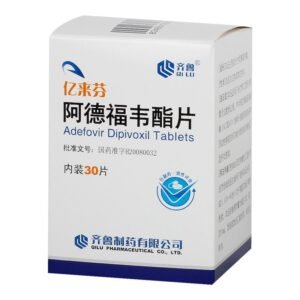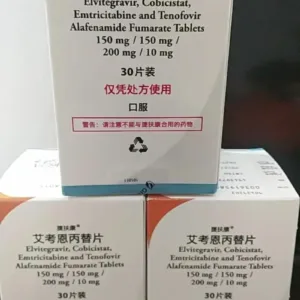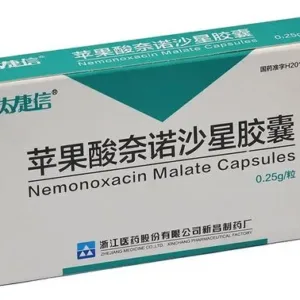Adefovir Dipivoxil Tablets
Effects and efficacy:
Adefovir dipivoxil is suitable for the treatment of adult chronic hepatitis B patients with evidence of active replication of hepatitis B virus, accompanied by persistent elevation of serum aminotransferase (ALT or AST) or liver function compensation with active histological lesions of the liver. This product can be used to alleviate organ physiological changes caused by viral replication, such as diseases that affect liver cell damage and liver function damage or abnormalities after chronic hepatitis B. In addition, Adefovir dipivoxil has clinical experience in treating AIDS.
Dosage and administration:
Patients must use Adefovir dipivoxil under the guidance of a physician with experience in treating chronic hepatitis B. Usage: Oral, before or after meals. Food does not affect the pharmacokinetics of Adefovir. Dosage: The recommended dose of Adefovir dipivoxil for adults (18-65 years old) is 1 tablet once a day. The optimal course of treatment has not yet been determined, and do not exceed the recommended dose. Please follow the doctor's advice for medication details. Patients should regularly monitor hepatitis B biochemical indicators, virological indicators and serum markers at least once every 6 months. Mild renal impairment (creatinine clearance ≥ 50ml/min) has little effect on the metabolism of adefovir dipivoxil. Patients with moderate and severe renal impairment (creatinine clearance < 50ml/min) or patients with end-stage renal disease need hemodialysis and adjustment of medication intervals. Moderate and severe liver damage has little effect on the pharmacokinetics of adefovir dipivoxil and does not require dosage adjustment.
Drug contraindications:
Athletes who are allergic to this product should not use it with caution
Related dosage forms:
Capsules, tablets
Read more
Add to Compare
Aminosalicylic Acid Enteric-coated Granules
Effects and efficacy:
Sodium para-aminosalicylate enteric-coated tablets are suitable for pulmonary and extrapulmonary tuberculosis caused by Mycobacterium tuberculosis, and are mainly used as second-line anti-tuberculosis drugs. This product is only effective against mycobacteria, and is ineffective against atypical mycobacteria. When this product is used alone, Mycobacterium tuberculosis can quickly develop drug resistance to this product, so it must be used in combination with other anti-tuberculosis drugs. Streptomycin and isoniazid can delay the development of drug resistance of Mycobacterium tuberculosis to the former two when used in combination with sodium para-aminosalicylate enteric-coated tablets.
Usage and dosage:
Sodium para-aminosalicylate enteric-coated tablets are used orally, and the specific dosage should be strictly followed according to the doctor's instructions. The same drugs produced by different manufacturers may have inconsistent contents in the instructions. If you find that the contents of the drug instructions are inconsistent before taking the medicine, please consult a doctor or pharmacist in time. Adults: 0.5g/tablet preparation, 4 to 6 tablets at a time, 16 to 24 tablets a day, 4 times a day. Children: 0.2 to 0.3g/kg per day according to body weight; divided into 3 to 4 times, the daily dose for children shall not exceed 12g.
Drug contraindications:
Contraindicated if allergic to this product
Related dosage forms:
Enteric-coated tablets
Read more
Add to Compare
Ampicillin Sodium and Sulbactam Sodium for Injection.
Ampicillin-sulbactam is suitable for hepatobiliary system, urinary system, skin and soft tissue infections caused by β-lactamase-producing Haemophilus influenzae, Moraxella catarrhalis, Neisseria gonorrhoeae, Staphylococcus, certain Escherichia coli, Klebsiella, Proteus mirabilis, Bacteroides fragilis, Acinetobacter, Enterococcus, etc. It is particularly suitable for mixed infections of aerobic and anaerobic bacteria, especially abdominal and pelvic infections. This product is also effective for the above-mentioned infections caused by ampicillin-sensitive bacteria. This product should not be used for infections caused by Pseudomonas aeruginosa, Citrobacter, Providencia, Enterobacter, Morganella and Serratia.
Read more
Add to Compare
E/C/F/TAF、أقراص إلفيتغرافير، كوبيسيستات، إمتريسيتابين، وتينوفوفير ألافيناميد فومارات.艾考恩丙替片
التأثيرات:
يستخدم هذا المنتج بشكل أساسي لعلاج عدوى فيروس نقص المناعة البشرية-1 (HIV-1).
الجرعة وطريقة الاستخدام:
ينبغي أن يبدأ العلاج باستخدام أكوينوكسالين من قبل طبيب ذي خبرة في إدارة مرض فيروس نقص المناعة البشرية. يجب أن يتم تحديد الجرعة المحددة ومسار العلاج من قبل الطبيب المختص. قبل البدء في استخدام هذا المنتج، يجب على المريض إجراء اختبار عدوى فيروس التهاب الكبد B، وتقييم وظائف الكلى، وتقييم مستويات الفوسفور في المصل لدى المرضى الذين يعانون من أمراض الكلى المزمنة. جرعة أقراص أكونتينيب: البالغون والمراهقون من عمر ١٢ عامًا فأكثر، بوزن لا يقل عن ٣٥ كجم: تناول قرصًا واحدًا مرة واحدة يوميًا مع الطعام. لا تمضغه أو تسحقه أو تكسره. كبار السن: لا يلزم تعديل جرعة أقراص إكوينوكسالين للمرضى المسنين. الأطفال: لم يتم إثبات سلامة وفعالية ICONITRILE في الأطفال الذين تقل أعمارهم عن 12 عامًا أو يزنون <35 كجم.
موانع الاستعمال:
لا يُستخدم إذا كنت تعاني من حساسية تجاه هذا المنتج. لا يُستخدم للأطفال. لا يُستخدم أثناء الحمل. يُستخدم بحذر عند الشرب. يُستخدم بحذر أثناء القيادة. يُستخدم بحذر أثناء الرضاعة. يُستخدم بحذر عند ضعف وظائف الكبد والكلى.
أشكال الجرعات ذات الصلة:
أقراص إيكونازول
Read more
Add to Compare
Ledipasvir and Sofosbuvir Tablets
Overview
Ledipasvir-sofosbuvir tablets are antiviral drugs, which are a combination of ledipasvir and sofosbuvir. Ledipasvir is an inhibitor of HCV NS5A protein. Sofosbuvir is an inhibitor of HCV NS5B RNA-dependent RNA polymerase.
What are the conditions for use?
It is used to treat chronic hepatitis C virus (HCV) infection in adults and adolescents aged 12 to <18 years.
How to take?
It can be taken on an empty stomach or with food.
Sit or stand and swallow the whole tablet with 200ml of warm water. Do not chew or crush the film-coated tablet.
How much to take? (Take as directed by a doctor or as follows)
For adults and adolescents aged 12-18 years, the recommended dose of this product is one tablet once a day.
It is suitable for the recommended duration of treatment for adults and adolescents (12-18 years) with HCV genotype 1, 2, 4, 5 or 6 HCV mono-infection and HCV/HIV-1 co-infection.
Adults and adolescents 12 years or older with HCV genotype 1, 4, 5, or 6:
[Patients without cirrhosis]
Take 12 weeks of Ledipasvir-Sofosbuvir. For patients with genotype 1 infection who have not been treated previously, consider 8 weeks of Ledipasvir-Sofosbuvir.
[Patients with compensated cirrhosis]
Take 12 weeks of Ledipasvir-Sofosbuvir plus ribavirin A, or 24 weeks of Ledipasvir-Sofosbuvir without ribavirin. For patients who are considered to be at low risk of clinical disease progression and have options for subsequent retreatment, consider 12 weeks of Ledipasvir-Sofosbuvir without ribavirin.
[Patients without cirrhosis or after liver transplantation with compensated cirrhosis]
Take 12 weeks of Ledipasvir-Sofosbuvir plus ribavirin A. For patients who are not suitable for or cannot tolerate ribavirin, consider 12 weeks (patients without cirrhosis) or 24 weeks (patients with cirrhosis) of Ledipasvir-Sofosbuvir Tablets (without ribavirin).
[Patients with decompensated cirrhosis (regardless of transplant status)]
Take 12 weeks of Ledipasvir-Sofosbuvir Tablets + Ribavirin B. For patients who are not suitable for or cannot tolerate ribavirin, consider 24 weeks of Ledipasvir-Sofosbuvir Tablets (without ribavirin).
Adults and adolescents 12 years or older with genotype 3 HCV:
[Patients with compensated cirrhosis and/or previous treatment failure]
Take 24 weeks of Ledipasvir-Sofosbuvir Tablets + Ribavirin A.
Adult patients with genotype 2 HCV:
Take 12 weeks of Ledipasvir-Sofosbuvir Tablets.
A Adults: Weight-based ribavirin (<75kg=1,000 mg, ≥75kg=1,200 mg), divided into two doses to be taken orally with food. Adolescents: For ribavirin dosing recommendations, see the following ribavirin dosing regimens recommended for adolescent patients aged 12 to <18 years.
B For ribavirin dosing recommendations for patients with decompensated cirrhosis, see below.
Ribavirin dosing recommendations for patients with decompensated cirrhosis when administered in combination with Ledipasvir Sofosbuvir Tablets:
[Patients with Child-Pugh-Turcotte (CPT) B cirrhosis before transplantation]
For patients weighing <75kg, the dose is 1000mg/day; for patients weighing ≥75kg, the dose is 1200mg/day.
[Pre-transplant CPT C cirrhosis; post-transplant CPT B or C cirrhosis]
The starting dose is 600 mg, and if well tolerated, the dose can be increased to a maximum of 1000/1200 mg (1000 mg for patients weighing <75 kg; 1200 mg for patients weighing ≥75 kg). If the starting dose is poorly tolerated, the dose should be reduced based on hemoglobin levels as clinically indicated.
If a more normalized ribavirin dose (by weight and renal function) cannot be achieved for tolerability reasons, 24 weeks of ledipasvir/sofosbuvir + ribavirin should be considered to minimize the risk of relapse.
The following ribavirin dosing regimen is recommended for adolescent patients 12 to <18 years of age when given in combination with ledipasvir-sofosbuvir tablets, where the ribavirin dose is given twice daily with food:
[Weight <47 kg]: The dose used is 15 mg/kg/day.
【Weight 47-49kg】: The dosage is 600mg/day.
【Weight 50-65kg】: The dosage is 800mg/day.
【Weight 66-74kg】: The dosage is 1000mg/day.
【Weight> or =75kg】: The dosage is 1200mg/day.
Guidelines for adjusting the dose of ribavirin in adults when used with Ledipasvir-Sofosbuvir tablets:
【Hemoglobin level in patients without heart disease】
If <10g/dL, the dose of ribavirin should be reduced to 600mg/day. If <8.5g/dL, ribavirin should be discontinued.
【Hemoglobin level in patients with a stable history of heart disease】
If <10g/dL, the dose of ribavirin should be reduced to 600mg/day, and the hemoglobin decrease should be ≥2g/dL during any 4-week treatment period. If <8.5g/dL, ribavirin should be discontinued, and levels remain <12g/dL despite dose reduction during 4 weeks of treatment.
After ribavirin is discontinued due to laboratory abnormalities or clinical abnormalities, an attempt can be made to restart ribavirin at 600 mg per day and further increase the dose to 800 mg per day. However, it is not recommended to increase ribavirin to the originally assigned dose (1000mg-1200mg per day).
If vomiting occurs within 5 hours of taking the drug, a second tablet should be taken. If vomiting occurs more than 5 hours after taking the drug, no second dose is required.
Read more
Add to Compare
Nemonoxacin Malate Capsules.
Nemofloxacin malate is an anti-infective drug. [1-2] It is used to treat mild, moderate, and severe community-acquired pneumonia in adults (≥18 years old) caused by Streptococcus pneumoniae, Staphylococcus aureus, Haemophilus influenzae, Haemophilus parainfluenzae, Moraxella catarrhalis, Klebsiella pneumoniae, Escherichia coli, Pseudomonas aeruginosa, Acinetobacter baumannii, Mycoplasma pneumoniae, Chlamydia pneumoniae, and Legionella pneumophila that are sensitive to nemofloxacin. [3]
Read more
Add to Compare
Norvancomycin Hydrochloride for Injection.
Effects and efficacy:
This product is used for: intravenous infusion of this product is suitable for endocarditis, osteomyelitis, pneumonia, sepsis or soft tissue infection caused by Staphylococcus (including methicillin-resistant strains that are sensitive to this product). Penicillin or cephalosporin cannot be used for patients with severe staphylococcal infection who are allergic to penicillin, or vancomycin can be used for patients with severe staphylococcal infection who are ineffective after the above antibacterial drugs. This product is also used to treat enterococcal endocarditis and Corynebacterium (diphtheroid bacilli) endocarditis in patients who are allergic to penicillin. Treatment of arteriovenous shunt infection caused by Staphylococcus in hemodialysis patients who are allergic to penicillin and not allergic to penicillin. Oral use for the treatment of pseudomembranous colitis.
Usage and dosage:
For injection, add an appropriate amount of injection water to dissolve before use. Slow intravenous infusion: 0.8g~1.6g (800,000~1.6 million units) per day for adults, divided into 2~3 intravenous infusions. Children take 16mg~24mg/kg (16,000~24,000 units/kg) of body weight per day, divided into 2 intravenous drips. Oral administration for the treatment of pseudomembranous colitis, 0.4g per time for adults, once every 6 hours, and the daily dose does not exceed 4g. Children should reduce the dosage accordingly. The same drugs produced by different manufacturers may have inconsistent instructions. If you find inconsistencies in the instructions before taking the medicine, please consult a doctor or pharmacist in time.
Drug contraindications:
Allergic to this product is prohibited. It is prohibited during pregnancy. It is used with caution in infants under 6 months old. It is used with caution in newborns. It is used with caution during lactation. It is used with caution in renal impairment.
Related dosage forms:
Injection
Read more
Add to Compare
Omadacycline Tosilate for Injection
Omadacycline tosylate is a product that Zai Lab introduced from Paratek* in 2017. It was launched in the United States in February 2019. On December 16, 2021, the indications of omadacycline tosylate (Neuzai) for the treatment of community-acquired bacterial pneumonia (CABP) and acute bacterial skin and skin soft structure infection (ABSSSI) were officially approved by the National Medical Products Administration (NMPA). ABSSSI is a bacterial infection with a lesion area of at least 75cm2 (the lesion area is calculated based on the measured congestion/erythema, edema or nodules and range), and the patient is also accompanied by systemic symptoms such as lymphadenopathy or fever (oral temperature ≥38℃). Common pathogens include Streptococcus pyogenes, other streptococci, and Staphylococcus aureus.
Antibacterial activity characteristics
This drug is a new tetracycline antibiotic, which is structurally modified on the basis of minocycline. It is designed to overcome bacterial resistance to existing tetracycline drugs and improve broad-spectrum antibacterial activity. According to the Sanford Fever Guidelines, aerobic Gram-positive bacteria with antibacterial activity include Enterococcus faecium, Enterococcus faecalis, VRE (±), MSSA, MRSA, Staphylococcus epidermidis, Staphylococcus lugdunensis, various streptococci (Streptococcus anthracis, Streptococcus pyogenes Group B Streptococcus, Streptococcus pneumoniae and Streptococcus viridans), Jack's Corynebacterium, Enterobacteriaceae resistant to ceftazidime and carbapenems, such as ESBL-producing Escherichia coli, KPC enzyme-producing Escherichia coli, MBL-producing Escherichia coli and Klebsiella pneumoniae producing the corresponding enzymes, ampicillin-resistant Haemophilus influenzae, Acinetobacter (Acinetobacter baumannii), MRSA, Stenotrophomonas maltophilia, etc. It has little activity against Pseudomonas aeruginosa, Proteus Morganella and Providencia. The antibacterial spectrum is almost the same as that of tigecycline.
Pharmacokinetic characteristics and differences of tigecycline
Picture
The drug has both intravenous and oral preparations, and the bioavailability of the oral preparation is 34.5%. The protein binding rate is 20%, and the half-life is 15.5~16.8 hours. The protein binding rate of tigecycline is 71-89%, the half-life is 42%, and the blood-brain barrier permeability of tigecycline is 0. Pharmaceutical trials and clinical pharmacology show that the pharmacokinetics (PK) of omadacycline tosylate is not affected by the patient's age, gender, liver and kidney function, etc. After entering the body, it is not metabolized and excreted from the feces. The corresponding patients do not need to adjust the dose when taking the drug. However, the dose of tigecycline needs to be reduced when the Child Pugh score is C.
Image
Recommended dose
Indications
Route of administration
Day 1
Maintenance
CAP
Intravenous
200mg (infusion over 60min)
100mg, once a day
100mg, two doses
100ng, once a day
Oral
300mg, two doses
300mg, once a day
ABSSSI
Intravenous
200mg (infusion over 60min)
100mg, once a day
100mg, two doses
100mg, once a day
Oral
450mg, qd first and second day
300mg, once a day
Image
Precautions for taking medicine
Image
The reconstituted solution of this medicine is orange or dark orange liquid. Use 100ml saline or 5% glucose. Do not use the same infusion line with drugs containing other cations such as calcium ions, magnesium ions, etc. If it is an oral preparation, fast for four hours before administration, fast for 2 hours after administration, and fast for dairy products and foods containing multivitamins for 4 hours after administration.
*(Partek Pharmaceuticals was founded in 1996 and is headquartered in Boston, Massachusetts, USA. It is a commercial-stage biopharmaceutical company focused on the development and commercialization of therapeutic drugs based on biology and tetracycline chemistry to meet critical medical needs in the treatment of infectious diseases.)
Read more
Add to Compare
Simnotrelvir/Ritonavir
Effects and efficacy:
For the treatment of adult patients with mild to moderate novel coronavirus infection (COVID-19).
Dosage and administration:
Oral administration, on an empty stomach. Tablets must be swallowed whole and must not be chewed, broken or crushed. This product is a combination of sennotevir tablets and ritonavir tablets. Sennotevir must be taken with ritonavir. If not taken with ritonavir, the plasma level of sennotevir may not be sufficient to achieve the desired therapeutic effect. It should be used as soon as possible within 3 days or less of the first onset of symptoms. The recommended dose is sennotevir 0.750 g (2 tablets) combined with ritonavir 0.1 g (1 tablet), taken orally once every 12 hours for 5 consecutive days. Special populations Hepatic impairment This product has not yet been clinically studied in subjects with hepatic impairment. Ritonavir is mainly metabolized and cleared by the liver, and patients with severe hepatic insufficiency should not use this product. Renal impairment This product has not yet been clinically studied in subjects with renal impairment.
Adverse reactions:
Possible adverse reactions of Senotegravir Tablets/Ritonavir Tablets: Metabolic and nutritional diseases: dyslipidemia, hyperuricemia. Gastrointestinal system diseases: common diarrhea, nausea; occasional vomiting, abdominal distension. Skin and subcutaneous tissue diseases: itching, rash. Heart disease: sinus bradycardia. Other abnormal examination indicators: decreased neutrophil count, increased blood creatine phosphatase, decreased platelet count.
Drug contraindications:
Allergic to this product is prohibited during pregnancy.
Read more
Add to Compare
Product Categories
- A الهضم والتمثيل الغذائي
- B تداول البلازما
- C نظام القلب والأوعية الدموية
- D الاستعدادات الجلدية
- DR\MR المطور المحسن
- E أدوية الجهاز المكونة للدم
- F نظام الدماغ القحفي
- G الجهاز البولي التناسلي
- H الاستعدادات الهرمونية
- K الهرمونات الجنسية
- M الجهاز العضلي الهيكلي
- N أدوية الجهاز العصبي
- O الأدوية المساعدة للأورام
- P مضادات الديدان
- R الجهاز التنفسي
- S الفم والعينين والأنف والأذنين
- Vترياق التسمم
- W الحد من البرد والحمى
- X أمراض معدية
- أدوية الأورام
- الأدوات الطبية
- الأدوية المضادة للعدوى
- السواغات الطبية
- الطعام الصحي
- منتجات الصحة الجنسية
Brands
Selected static block was removed or unpublished









